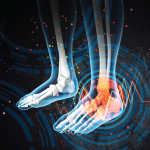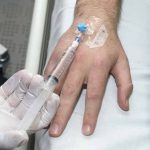Results: The proportion of patients who experienced disease remission after 30 weeks was 50.5% in the therapeutic drug monitoring group and 53% in the standardized therapy group—a difference that was not statistically significant. At week 14, 49.1% of patients in the therapeutic drug monitoring group and 54.7% of patients in the standard therapy group attained clinical remission—again, not statistically significant difference. The median time to remission was 56 days in the therapeutic drug monitoring group and 46 days in the standard therapy group. The researchers found no significant differences between the groups in time to remission or time to sustained remission.
The investigators documented adverse reactions in 68% of patients in the therapeutic drug monitoring group and 70% of patients in the standard therapy group (not statistically different). Infliximab was discontinued in 30% of patients in the therapeutic drug monitoring group and 22% of patients in the standard therapy group (not statistically different). The most frequent adverse events were related to infections, including upper respiratory tract infection, influenza-like illness and lower urinary tract infection.
The investigators concluded that therapeutic drug monitoring was not superior to standard treatment for achieving disease remission. However, they note the trial did not have statistical power to test hypotheses within each disease subgroup.
Old School Medicine Works
Dr. Syversen expressed surprise that therapeutic drug monitoring did not improve efficacy. “We believe that negative data are also important for clinical practice,” Dr. Syversen says, noting that the findings stand in contrast to the fact that proactive therapeutic drug monitoring has been adopted in multiple different specialties.
“We feel that our results put to rest a long-standing debate on the merit of therapeutic drug monitoring in all patients starting TNFi,” she says. Dr. Syversen suggests that, because the previous studies were observational, they may have been affected by confounding and selection bias.
“It’s reassuring that what we do works,” says Brett Smith, DO, a rheumatologist at Blount Memorial Physicians Group, Alcoa, Tenn. “It reinforces that we have the best clinical practice at this time. We can usually tell when we lose response. … After the disease shifts, we know it’s over at that point.” Dr. Smith is also impressed by the fact that the study reported consistent findings across six diseases.
“Our clinical skills are the most important things that we have,” says Dr. Smith, noting the study emphasized the importance of “old school medicine.”
Important Caveats
Dr. Syversen acknowledges that a more targeted application of therapeutic drug monitoring, such as assessment of serum drug levels in treatment failures, may still be a useful clinical tool. This approach would include applying therapeutic drug monitoring and following up closely in patients with risk factors for immunogenicity and those for whom emerging treatment failure is suspected.


